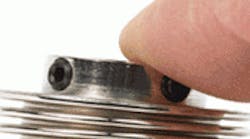Bellows and their key design feature — flexible rigidity — are the oxymoron of the industrial components world: They must be strong enough to withstand pressure throughout their circumference, yet flexible enough to bend along their length.
The challenge of bellows design is to balance flexibility and rigidity with application requirements to provide a bellows with a long and reliable term of service. Metal bellows are incredibly diverse components: They find use as metallic hermetic seals, volume compensators, pressure and temperature sensors, flexible connectors, and in myriad other applications where high quality and long life are critical requirements, such as in the aerospace industry.
As a result of these widespread applications, many bellows designs are highly specialized. When specifying a custom design, 12 attributes are vitally important and should be communicated with the bellows supplier. Further details may be necessary, but these factors will provide a solid framework for the initial design:
Stress modes: Specify the extension, compression, bending, swiveling, parallel-end offset, torque, and speed of rotation. Better yet, provide a drawing or sketch showing extremes of flexing whenever possible.
Flexing: Detail the maximum amount of stroke (axial compression or extension) and offset in inches, or bend angle in degrees, or by dimensions on a diagram.
Pressure differential: Specify the pressure difference between the inside and outside of the bellows, maximum instantaneous pressure, and whether higher pressure is applied inside or outside of the bellows.
Rigid stops: Determine whether rigid stops will limit the extension or compression of the bellows to its rated stroke, or if the bellows will be required to withstand pressure unrestrained. Note: A restrained bellows usually provides better performance because it continually operates within design parameters.
Spring rate: Specify the required spring rate in pounds per inch, or conversely, the amount of force available to flex the bellows the desired amount.
Life cycles: Establish the required useful life of the bellows, expressed as the number of flexing cycles. Define the flexing cycle.
Define temperature extremes: Indicate both upper and lower temperature extremes.
Exposure: Specify the media (liquid or gas) to which the internal and external bellows surfaces will be exposed. Identify potentially corrosive conditions or agents.
Assembly method: The method to be used to join the bellows to end fittings, such as soldering, brazing, welding, or cementing, should be clarified.
Vibration: Describe the vibration or shock conditions that the bellows will experience in as much detail as possible.
End configuration: Specify the types and lengths of the bellows ends.
Geometric constraints: Specify restrictions on the bellows size, including maximum OD, minimum ID, maximum overall length, and other known dimensions.
Q&A
Here we discuss custom bellows design, but are there applications where off-the-shelf, standard designs are useful?
When a designer is working to create a new device or looking to enhance an existing assembly by using a bellows, it's always smart to verify whether an off-the-shelf bellows can meet or approximately meet the desired design requirements. Designers can incorporate a standard product with greater availability, competitive pricing, and lower cost for prototype and test feasibility. Off-the-shelf parts also save development time and money and allow devices to go to market faster.
When designing a custom bellows, how do you determine the tradeoff between rigidity and flexibility?
The application determines the tradeoff. Some application requirements call for more flexibility than is possible when considering the rigidity requirement (such as deflection versus pressure) or vice versa. That's why it is best to get in touch with an experienced bellows design engineer at the design concept stage — before finalizing requirements and creating a “flexibility versus rigidity” conflict that would compromise the design's success.
How do electrodeposited metal bellows vary from other types of bellows?
Formed bellows are created by mechanically deforming metal from a straight tube into a convoluted tube, while edge welded bellows are manufactured by welding metal diaphragms along the inside diameter and alternating outside diameters. In contrast, electrodeposited bellows are created by electroplating a precise thickness of metal onto a convoluted mandrel that has been machined to the exact internal dimensions of the desired bellows. This mandrel is then removed chemically, leaving behind the electroplated metal shell as the bellows
Tips provided by Servometer/PMG LLC. For more information, call (973) 785-4630 or visit servometer.com.
